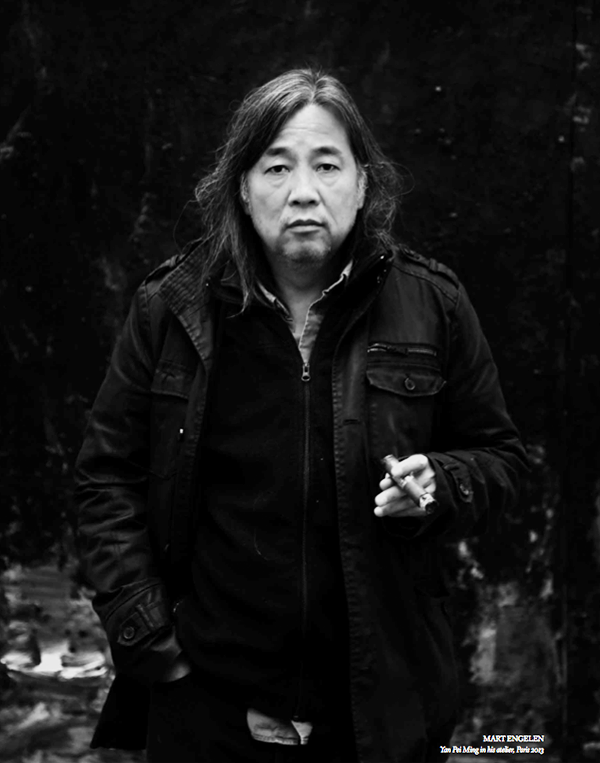Yan Pei-Ming
Interview and Photography by Mart Engelen
Last November Galerie Thaddaeus Ropac hosted the opening of the exhibition ‘HELP’ by one of the most dynamic and experimental Chinese painters in the inter- national art scene, Yan Pei-Ming. I visited Yan Pei-Ming in his Paris atelier and we talked about his life and art.
Courtesy Museo Carlo Mollino
Mart Engelen: Your current exhibition at the Ropac Gallery has the title ‘HELP’. Why?
Yan Pei-Ming: Because it’s the title of one of the paintings and at the same time I wanted to use the word ‘HELP’ because it means a lot. It’s like the story of the boy who cried wolf, the more you yell for help the less you get. It’s like a story of what’s happening in today’s world.
ME: Which painting in the exhibition has the title ‘HELP’?
YPM: It’s the little boy on his knees with his hands up in the air.
ME: You are one of the few artists these days who uses political situations directly in his art. Why?
YPM: We, as human beings, cannot live an insensitive life. We cannot hide away. I am a painter who is very interested in douleur de l’homme. I like to express myself on social mat- ters, politics, the times we are living in now, and also war. When I say ‘war’ I mean past wars, yesterday, today and tomorrow. It will be always an eternal and current topic. My vision of this world is actually very pessimistic.
ME: If we go back to the themes of this exhibi- tion—peace, war, money, death and beauty— what function does beauty play?
YPM: Beauty is hidden in the basement. [haha] ME: ?
YPM: In this exhibition, the paintings on the theme of beauty are displayed in the basement of the gallery. In war, beauty is in a way always hid- den.
ME: So that’s the only positive aspect of your pessimistic vision?
YPM: Yes. Beauty as an icon is very important to me.
ME: In an interview you said, “When a viewer shares my vision I can say ‘Thank you’ but if he doesn’t then I say, ‘OK, sadly, that’s too bad for you or it’s too bad for me’.” What is your vision? YPM: I am a pessimist. I work in my studio with great joy and pleasure but I am painting man’s suffering.
ME: How does this affect you, working with pleasure on unhappiness?
YPM: I really have to express myself. I don’t like to show happiness. Happiness I keep for myself. ME: Why did you choose to make this exhibition black and white?
YPM: I have chosen to do this exhibition in black and white to convey the drama of the subject. Colour would have no function at all. It had to be powerful, sober, and with a lot of emotion and feelings; although these days it’s not really politically correct for artists to show emotion in art.
ME: That’s interesting. It’s actually what I re- ally like about your art. Why isn’t it accepted? YPM: It will be accepted. I want to launch a new generation of artists who will work and show their work with emotion and feelings. I would like to create ….
ME: A movement?
YPM: No. I don’t need to resemble other art- ists. I have to be myself and express myself. I paint what I see. I make a statement but I don’t judge.
ME: But do you take sides in your paintings? YPM: I am on the side of the weak. Because I am weak. I am a weak man but I also defend the weak. I express weakness through the strength of my paintings.
ME: Can we save the world?
YPM: I don’t believe that man will improve this world. Man is actually destroying our world. Man is too clever. We are exploiting all its re- sources without limit. How can you stop man? Man doesn’t stop. We are destroying this world in the name of science, development, freedom, etc. My vision of the world is very dark. But at the same time it’s the subject of my creation. ME: What is your next project?
YPM: I am preparing my next project [opening in February 2014] for the Massimo De Carlo gallery in London. I will be showing paintings of Pope Innocent X après Velasquez that I am working on. At one and the same time it’s about power. The purpose of power; the history, be- lief, religion, scandal, etc. What also intrigues me is the fact that the Pope’s clothing never changed. And the seat of power is always there. For centuries. Why London? Because Francis Bacon was also inspired by Velasquez’s paint- ing of the Pope and he has always lived in Lon- don. I want to bypass Bacon and go directly to the inspiration of the painting of the Pope by Velasquez. So I will show portraits of different dimensions and with different gestures.
ME: Why are the gestures in every painting different?
YPM: It’s not a copy of the painting by Ve- lasquez. It’s an interpretation. It’s a process. ME: Why are all the paintings in different col- ours?
YPM: I wanted to use different colours other- wise it would be boring. I wanted to have dif- ferent colours and gestures in the paintings. But the face never changes and the seat of power also never changes.
ME: Thank you for this conversation.
YPM: Thank you.

